Bushmeat
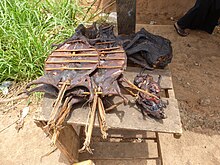 Bushmeat is often smoked to preserve it | |
| Alternative names | Wild meat, wild game |
|---|---|
| Main ingredients | Wildlife |
Bushmeat is meat from wildlife species that are hunted for human consumption. Bushmeat represents a primary source of animal protein and a cash-earning commodity in poor and rural communities of humid tropical forest regions of the world.[1][2]
The numbers of animals killed and traded as bushmeat in the 1990s in West and Central Africa were thought to be unsustainable.[3] By 2005, commercial harvesting and trading of bushmeat was considered a threat to
Bushmeat provides increased opportunity for transmission of several
Nomenclature
The term 'bushmeat' is originally an African term for wildlife species that are hunted for human consumption,[2] and usually refers specifically to the meat of African wildlife.[9] In October 2000, the
Wildlife
Affected wildlife species
Globally, more than 1,000 animal species are estimated to be affected by hunting for bushmeat.[1] Bushmeat hunters use mostly leg-hold
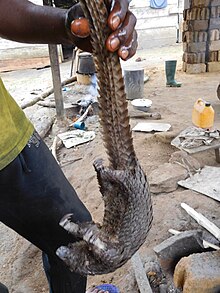
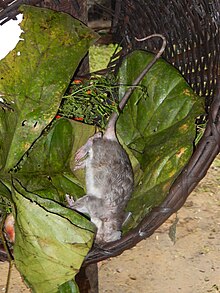

The volume of the bushmeat trade in
The 301 mammal species threatened by hunting for bushmeat comprise 126 primates, 65 even-toed ungulates, 27 bats, 26 diprotodont marsupials, 21 rodents, 12 carnivores and all pangolin species.[5]
Primate species offered fresh and smoked in 2009 at a wildlife market by Liberia's
In 2006, it was estimated that about 1,437,458 animals are killed every year in the
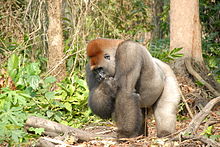
Between 1983 and 2002, the
In the late 1990s, fresh and smoked bonobo (Pan paniscus) carcasses were observed in Basankusu in the Province of Équateur in the Congo Basin.[21] The main species killed by bushmeat hunters in Tanzania's

A survey in a rural area in southwestern Madagascar revealed that bushmeat hunters target
Dynamics
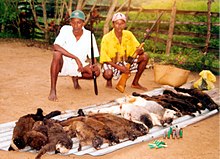
Logging
Nutrition
Bushmeat can be an important source of
Overfishing
In
Pastoralism
Role in spread of diseases
Animal sources may have been the cause for infectious diseases such as
Outbreaks of the Ebola virus in the
Many hunters and traders are not aware of zoonosis and the risks of disease transmissions.[31] An interview survey in rural communities in Nigeria revealed that 55% of the respondents knew of
HIV
Results of research on wild chimpanzees in Cameroon indicate that they are naturally infected with the
Ebola
The natural reservoirs of ebolaviruses are unknown.[36][37][38] Possible reservoirs include non-human primates,[36] megabats, rodents, shrews, carnivores, and ungulates.[39] Between October 2001 and December 2003, five Ebola virus outbreaks occurred in the border area between Gabon and Republic of Congo. Autopsies of wildlife carcasses showed that chimpanzees, gorillas and bay duikers were infected with the virus.[40] The Ebola virus has been linked to bushmeat, with some researchers hypothesizing that megabats are a primary host of at least some variants of Ebola virus. Between the first recorded outbreak in 1976 and the largest in 2014, the virus has transferred from animals to humans only 30 times, despite large numbers of bats being killed and sold each year. Bats drop partially eaten fruits and pulp, then terrestrial mammals such as gorillas and duikers feed on these fruits. This chain of events forms a possible indirect means of transmission from the natural host to animal populations.[41] The suspected
Results of a study conducted during the Ebola crisis in Liberia showed that socio-economic conditions affected bushmeat consumption. During the crisis, there was a decrease in bushmeat consumption and daily meal frequency. In addition, preferences for bushmeat species stayed the same.[43]
Parasites
In Cameroon, 15 primate species were examined for
Management
Suggestions for reducing or halting bushmeat harvest and trade include:[46]
- increase access of consumers to affordable and reliable alternative sources of animal protein such as farmed fishraised at family level;
- devolve rights and authority over wildlife to local communities;
- strengthen the management of protected areas and enforce wildlife conservation laws.
As an alternative to bushmeat, captive breeding of species traditionally harvested from the wild is sometimes feasible. Captive breeding efforts must be closely monitored, as there is risk they can be used to launder and legitimize individuals captured from the wild, similar to the laundering of wild green tree pythons in Indonesia for the pet trade.[25]
See also
- Cat meat
- Dog meat
- Game– animals hunted for food
- Indigenous cuisine of the Americas
- Malnutrition
- Roadkill cuisine
- Wildlife trafficking and emerging zoonotic diseases
- Yewei – wildlife meat sold at Chinese wet markets
 Food portal
Food portal
References
- ^ a b c Nasi, R.; Brown, D.; Wilkie, D.; Bennett, E.; Tutin, C.; Van Tol, G. & Christophersen, T. (2008). Conservation and use of wildlife-based resources: the bushmeat crisis (PDF). CBD Technical Series no. 33. Montreal and Bogor: Secretariat of the Convention on Biological Diversity and Center for International Forestry Research (CIFOR). pp. 1–50.
- ^ S2CID 38428707.
- .
- .
- ^ PMID 27853564.
- ^ PMID 9126445.
- ^ S2CID 9159650.
- PMID 19787649.
- ^ Hall, Jani (2019-06-19). "Bushmeat, explained". National Geographic. Archived from the original on April 10, 2021. Retrieved 2022-05-18.
- ISBN 9782831706382.
- .
- S2CID 83996789.
- S2CID 55246983.
- S2CID 84561619.
- .
- .
- PMID 22514356.
- .
- S2CID 5905831.)
{{cite journal}}: CS1 maint: multiple names: authors list (link - ^ Bahaa-el-din, L.; Henschel, P.; Aba’a, R.; Abernethy, K.; Bohm, T.; Bout, N.; Coad, L.; Head, J.; Inoue, E.; Lahm, S.; Lee, M. E.; Maisels, F.; Rabanal, L.; Starkey, M.; Taylor, G.; Vanthomme, A.; Nakashima, Y.; Hunter, L. (2013). "Notes on the distribution and status of small carnivores in Gabon". Small Carnivore Conservation (48): 19–29.
- doi:10.5134/143400.
- .
- S2CID 154683918.
- S2CID 42668922. Archived from the original(PDF) on 2019-12-26. Retrieved 2019-12-26.
- ^ .
- S2CID 51325711.
- S2CID 213766740.
- PMID 2820094.
- PMID 15911757.
- PMID 16485465.
- S2CID 22594553.
- PMID 26001078.
- PMID 16728595.
- PMID 22229120.
- PMID 21126914.
- ^ a b "What is Ebola Virus Disease?". Centers for Disease Control and Prevention. 5 November 2019. Retrieved 25 March 2021.
Scientists do not know where Ebola virus comes from.
- PMID 25960093.
Despite concerted investigative efforts, the natural reservoir of the virus is unknown.
- PMID 27959626.
The geographic ranges of many animal species, including bats, squirrels, mice and rats, dormice, and shrews, match or overlap with known outbreak sites of African filoviruses, but none of these mammals has yet been universally accepted as an EBOV reservoir.
- .
We found published evidence from cases of serological and/or polymerase chain reaction (PCR) positivity of EVD in non- human mammal, or of EVD-linked mortality, in 28 mammal species: 10 primates, three rodents, one shrew, eight bats, one carnivore, and five ungulates
- PMID 15752448.
- PMID 17848072.
Together, field and experimental findings indicate the plausibility of the hypothesis that certain species of bat serve as the principal reservoir host for at least some variants of Ebola virus.
- PMID 25550396.
- PMID 28282378.
- PMID 20970258.
- PMID 29030787.
- .
External links
- "The Bushmeat Project". Biosynergy Institute.
- "Bushmeat". Ape Alliance – Action for Apes.
- "Action on wildlife trade". Traffic.
- Science. Retrieved May 26, 2017.
- "Understanding the bushmeat market: why do people risk infection from bat meat?". Research News. University of Cambridge. 2014.
- "FAO warns of fruit bat risk in West African Ebola epidemic". Food and Agriculture Organisation News. 2014.
- "Bushmeat consumption, wildlife trade and global public health risks". Food and Agriculture Organisation News. 2010.
- "What does Elephant Meat Taste Like?". Foodlve Blog. 2023.


